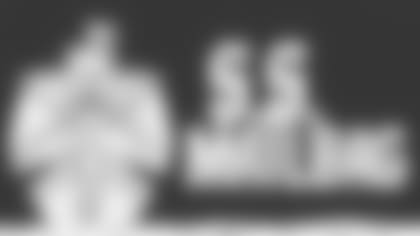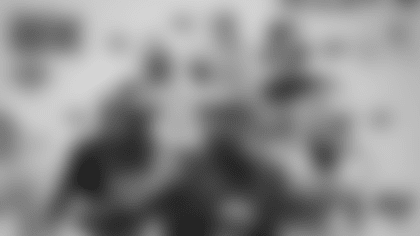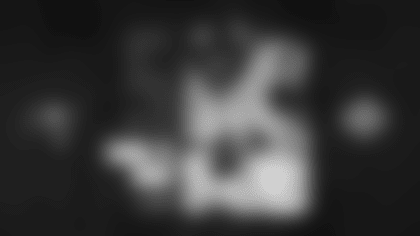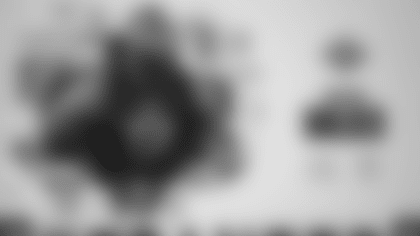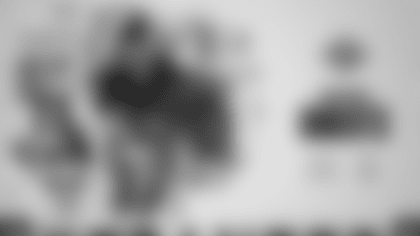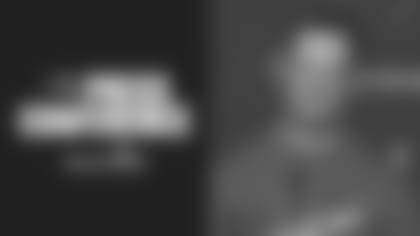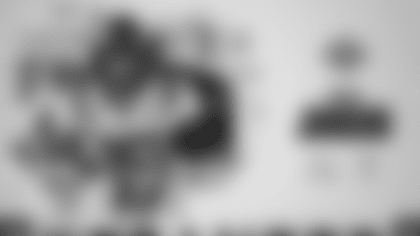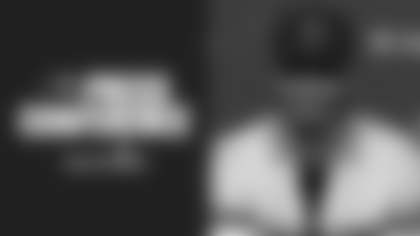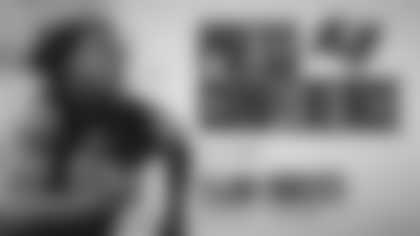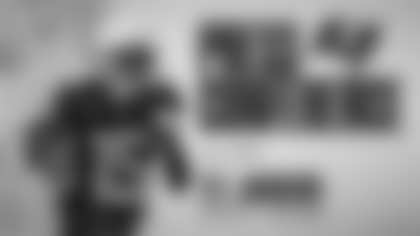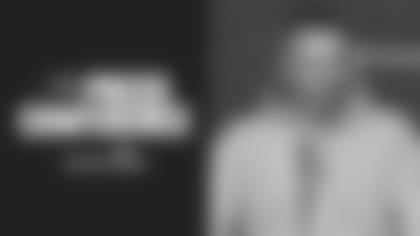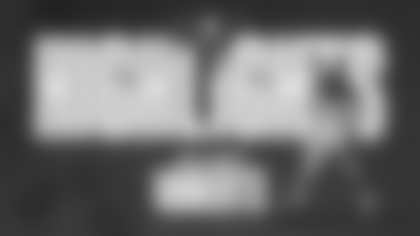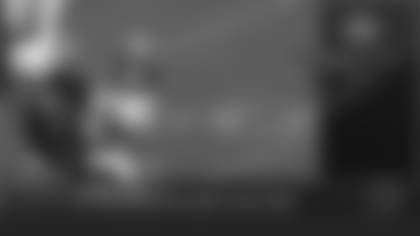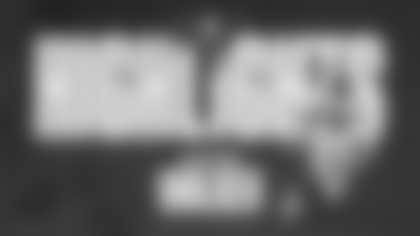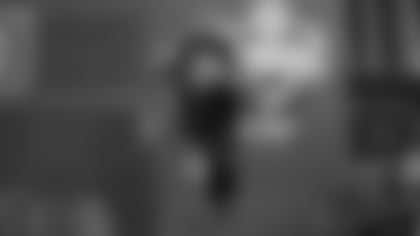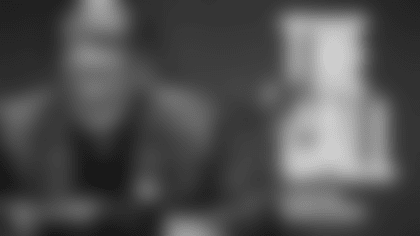I only take the S.S. Mailbag out of the dock once a week, but Casey Phillips and I routinely answer about 15 minutes' worth of fans' questions on our weekly Insider Live (here's a handy archive of some of our most recent shows!). One thing we're asked about every week is upcoming training camp position battles. Is Chris Godwin going to force his way into the starting lineup. Which of the young cornerbacks is going to play the most? Who is the right guard?
These things are obviously foremost on the minds of Bucs fans at this point in the year. So, before I get to your questions, I'm going to preemptively tackle this issue and identify what I think are the five biggest position battles we'll be watching in camp. Let's get to it.
5. Kickoff/Punt Returner.This isn't the most significant battle on this list, but it might be the most wide open. The incumbents for those spots are essentially Jacquizz Rodgers on kickoffs and Adam Humphries on punts, and both could handle the same jobs ably in 2018. Still the Bucs have seemingly been in search of big plays in that area since the days of Clifton Smith, and a newcomer who could provide such a spark might win one or both of those jobs, and maybe a roster spot in the process. That wouldn't be an issue for Ronald Jones, but it could be important for undrafted rookie RB Shaun Wilson. Cornerback M.J. Stewart got some kick-return work at North Carolina. Safety Jordan Whitehead didn't really get involved in the return game at Pitt but he was used as a ballcarrier on occasion; perhaps he could be in the picture. And lest we forget, Bernard Reedy is back.
Or, here's another option:
4. Running Back. I almost hesitate to put this one on the list because, as I've said several times on Insider Live, I don't think it's necessarily critical for either Jones or Peyton Barber to be officially listed as the starter. I expect them both to get plenty of work. But it will be interesting to see if Jones can immediately grab the bigger share of the backfield workload with a strong training camp/preseason. Also, there is more at stake here than just the first line on the depth chart. Will the Bucs go into 2018 with Jones and their same three holdovers from last year – Barber, Rodgers and Charles Sims – or could somebody like Wilson or Dalton Crossan force his way into the mix.
3. Right Guard. If the season were to start today, I think the answer would be Caleb Benenoch. That said, if the season were to start today, the Bucs would be in need of a right tackle, too, thanks to Demar Dotson's ongoing rehab. Benenoch finished last year in that spot and would surely be a top consideration. So if Dotson isn't ready for the start of the season (the current belief is that he will be ready), that might open up the guard spot for somebody else. Will J.R. Sweezy get back to full health and back into the mix? How quickly can rookie third-rounder Alex Cappa convince the coaching staff that he is a starting option? Obviously, the experienced and reliable Evan Smith is always an option.
2. Safety. The Bucs have a returning pair of starters in Justin Evans and Chris Conte, so this one could remain status quo. Still, these two positions have seemingly been open to competition for three or four years now. Evans, a second-round pick in 2017, essentially locked down one of the starting positions last year, so I think he's a good bet to stay in the lineup. Conte is, too, but he'll get competition from Keith Tandy, who wasn't completely healthy most of last season, and fourth-round draft pick Jordan Whitehead. Chances are they all will see playing time at some point during the season, but it will be interesting to see how quickly Whitehead can carve out a role of any significance. The Bucs also seem to like undrafted rookie Godwin Igwebuike a lot, though he will probably start out on special teams if he makes the active roster.
1. Cornerback. Given the Buccaneers' struggles in pass defense last year (admittedly due in large part to an anemic pass rush), and the fact that the team drafted not one but two cornerbacks in the second round a month ago, this one has to be the most pressing and complicated battle in camp. The Bucs like M.J. Stewart as a potential weapon in the slot and Carlton Davis as a matchup option against bigger receivers. Davis has already generated a lot of positive buzz during OTAs. Brent Grimes seems like a lock for one of the two outside spots and the Bucs still have high hopes for 2016 first-round pick Vernon Hargreaves. Ryan Smith got a lot of experience last year and is essentially an incumbent starter. There are a lot of moving pieces here, and it's far too early to know where they are all going to fit.
Alright, now on to your questions. A reminder that you can send questions to me anytime you want on Twitter (@ScottSBucs) and they're easier to find if you include the hashtag #SSMailbagBucs. As you'll see from time to time, I also unilaterally appropriate for myself – as any good pirate captain would – questions I like that are meant for our Insider Live show or are simply responses to one of my previous tweets. As always, if you'd prefer to email your question and maybe bust past that 280-character limit, you can do so to tbbsocial@buccaneers.nfl.com.
Since that tweet mentions both Will Gholston and Noah Spence, I'm not sure to which one your first question is referring, Lip. Gholston was listed at 281 last year, and still is this year and indeed that's been the weight for him on the roster since he's arrived. It surely hasn't stayed the same every year, but that's usually how these things work. So I'm guessing if he was heavier than he had been during his very effective 2016 season, he must have been closer to 300 pounds.
With Spence we have a more informed answer because Dirk Koetter said on Thursday that the third-year end had gotten down into the 230s during training camp last year. He might have put a few pounds back on during the season, but he only lasted six games before landing on injured reserve, so there probably wasn't much of a difference by then. The change has come since then, as he has both rehabbed his shoulder and put in a lot of work, obviously, in the weight room to add muscle to his frame.
I've got to imagine it's hard to play defensive end in the NFL at 230-ish pounds. Spence's game is speed and he's never going to be a JPP-like 280 or 290-pound end. He's an edge-rushing specialist (though he played better than anticipated against the run as a rookie in 2016), so he won't want to put on so much weight that it affects his speed. But Koetter said Spence's target playing weight is between 253 and 259 pounds, so the team obviously believes he can maintain that same speed at that higher weight.
Will it make him less susceptible to the shoulder injuries that have abbreviated his first two seasons? It doesn't seem to me like there would be a one-to-one corollary between being heavier and avoiding shoulder dislocations. I have certainly seen larger linemen suffer the same injury, and once you do have a dislocation, you're more likely to have another one if you return to action without some sort of additional procedure.
I talked to one of our trainers about this and he agrees that there isn't a direct correlation between adding weight and avoiding shoulder injuries. However, he does believe that getting bigger and stronger is going to make Spence more resilient overall. He'll be better equipped to hold his own in physical battles against larger offensive tackles, his primary foes on the field. This guy agrees:
You can also be certain that, in the process of adding muscle overall, Spence has specifically worked to strengthen all the structures around his shoulders. And, finally, this may not mean much, but I feel like Noah is due for a run of better luck in 2018.
Hey Scott, I've been a Bucs fan all 27 years of my life. Well I have to take my parents word for it on the first four or five years but I have seen pictures of a very little me in some sweet orange Bucko Bruce gear. So I'll save you the math and tell you that I was 11 when the Bucs won the Superbowl and it is still my happiest sports memory. As you know though, the Bucs could have been in the Superbowl three years earlier if the refs hadn't overturned that Bert Emanuel catch. I'm still mad about that and I always wonder what would've happened if that catch counted. That doesn't mean we would have one for sure but we would at least have had a shot. My question to you is, what's another play from Buc history that you could change if you could and maybe change a whole season outcome?
Thanks Scott – Mark from St. Pete(via email to tbbsocial@buccaneers.nfl.com)
Just in case there's anyone reading who doesn't know the play to which Mark is referring, let me explain.
In 1999, the Buccaneers rode a fantastic defense, led by NFL Defensive Player of the Year Warren Sapp, and a good running game all the way to the NFC Championship Game. That took place in St. Louis against Kurt Warner's high-powered Rams, also known as "The Greatest Show on Turf." It was a definite clash of styles, and for most of the game's 60 minutes, the Bucs' style won out. Tampa Bay had a weird little 6-5 lead with five minutes left, having bottled up a Rams attack that averaged 33 points per game during the regular season. Warner changed that with a 30-yard third-down touchdown pass to noted Buc-killer Ricky Proehl, just over the outstretched fingers of cornerback Brian Kelly, who had been left in one-on-one coverage by a blitz.
The Bucs still had a chance, and while their offense hadn't done much in the game, either, they managed to drive down to the Rams' 22. A field goal wouldn't help. Shaun King was sacked on first-and-10, making it second-and-23 back at the 35. On the next snap, Emanuel made a diving catch but it was eventually ruled an incompletion because the ball made contact with the ground. The ruling was upheld during a review that occurred during a timeout, with most of those viewing the game not even realizing what was going on and assuming it was going to be third-and-short. Emanuel secured the ball with two hands and didn't lose control of it at all when the ball contacted the ground, which should have made it a catch. In fact, the NFL clarified that distinction the following year and it became known as the Bert Emanuel rule.
Anyway, facing a third-and-23 with 47 seconds to go, the Bucs were in a tough spot, and two incompletions later their Super Bowl dreams were over…or, at least, delayed a few years. (By the way, I like your question, Mark, so I'm trying to ignore your egregious use of Super Bowl as one word. Not once but twice! This isn't easy for me. That's like nails on a chalkboard to my internal ear when I'm reading.)
You asked me for one play, but can I have a couple? Maybe three? Three's cool? Thanks! I want a couple shots at this because there's a very obvious one from a recent season that I feel like I have to include but it's not my favorite example. That one took place on Oct. 30, 2016, with the Oakland Raiders in town. The home team weathered most of Derek Carr's 513-yard passing performance and had a 24-17 lead with less than two minutes remaining. The Raiders had moved inside the Buccaneers' 10-yard line but faced a fourth-and-three at the five. When Carr's pass attempt to Michael Crabtree fell incomplete, it looked like the Bucs would be able to run out the clock on a victory.
However, a yellow flag also hit the turf, as cornerback Jude Adjei-Barimah was flagged for defensive holding. Gifted a new set of downs, the Raiders scored on the next play to tie it and then won in overtime. A long overtime. Exhausted from nearly five quarters of play, the Bucs' defense couldn't hold up against an Atlanta buzz saw four days later on a Thursday night. Those two losses dropped Tampa Bay to 3-5, and though it would go on to win six of its last games, the team would miss out on the playoffs on a tiebreaker against Detroit. You can never assume that anything that follows would stay the same if you go back and change one thing, but it's still hard to miss the implications here. Change that one play and the Bucs almost certainly beat the Raiders, and change one loss to a win and they are 10-6 and in the playoffs. I would like to change that fourth-down play to a simple incompletion without a flag and see what happens.
Here's another one. In 2005, the Buccaneers won the NFC South and opened the playoffs at home against Washington. Tampa Bay had a pretty good defense that season, and it was very good on this day, holding Washington just 120 total yards of offense. Surely that led to victory, right? How can a team win when it only manages 120 yards of offense? Well in this case, that team won thanks to a LaVar Arrington interception off Chris Simms that set up a one-play, six-yard touchdown drive, plus a fumble that turned directly into another score for the visitors.
Actually, that second play involved two Buccaneer fumbles. First running back Cadillac Williams lost the ball, but it was recovered by his teammate, guard Dan Buenning. Unfortunately, Buenning then fumbled and it was recovered by Washington's Sean Taylor, who ran it back 49 yards for the touchdown. Washington won the game, 17-10. If I only get to reverse one of those plays, I'll take the fumble, partly because Cadillac was one of my favorite players and I'd like that turnover off his record. That removes seven points and though that still only makes it a tie, the Bucs were threatening to score on that very drive. They were at the Washington 34 when Caddy lost the ball. Even a field goal would have provided the winning points.
Had the Bucs won that game, they would have headed to Chicago the following weekend to take on the 11-5 Bears in the Divisional round. Who knows what would have happened, but it's worth noting that the fifth-seeded Carolina Panthers beat the Bears that weekend, 29-21. The Bucs had won at Carolina in December, the game that essentially gave them the division title. That doesn't prove anything, but it certainly suggests that the Bucs would have had a shot at Soldier Field. The championship game in Seattle would have been a tougher task, but I still wish we would have found out how tough.
I'll go back a couple more years for my last one. The Bucs went into the 2003 season as defending champions, and they started that campaign with a dominant and inspiring 17-0 victory at Philadelphia, in the regular-season debut of the Eagles' new stadium, the Linc. After that game, a prominent member of the Bucs' defense told me he thought that 2003 team was even better than the one that had just won the Super Bowl. So how did that team end up at 7-9 when it was all over? Well, this particular one came off the rails in excruciatingly slow-mo fashion.
First there was the blocked extra point at the end of a Week Two game against the Panthers, which turned what should have been a 10-9 comeback win into an utterly demoralizing 12-9 overtime loss. Then there was the Week Four Monday night game against Tony Dungy's Indianapolis Colts. Tampa Bay held a 35-14 lead in that one with five minutes to go after Ronde Barber's pick-six off Peyton Manning. I'd rather not relive the details of those last five minutes (plus overtime), but suffice it to say that Manning led the most improbable comeback I've personally ever seen and the Colts win in overtime, 38-35. There are probably a half-dozen plays in that game I could pinpoint and only change one of them and the Bucs will win. Absolutely everything had to go wrong in those last five minutes (from the Bucs' perspective), and it did.
The Bucs still had convincing wins over Atlanta and Washington in that stretch and were 3-2 after five games, so the season was far from over. However, three straight narrow losses to New Orleans, Carolina and Green Bay, all with their own depressing moments, sunk the team at midseason and it never recovered.
The play I would like to change from that season is none of the ones listed above, but it did occur in that aforementioned Week Two loss to Carolina. In the third quarter, with the Bucs trailing 9-0, Brad Johnson threw a short pass to Mike Alstott, who rumbled up the field – Alstott always rumbled – for 12 yards. Wide receiver Joe Jurevicius was holding a downfield block for Alstott, but Alstott didn't get a chance to go around it as he was tackled into the back of Jurevicius' legs.
Both Buccaneer players were hurt in that collision. Jurevicius went directly to injured reserve the next week with a knee injury. Alstott made it a couple more games but then joined his teammate on I.R. with a neck ailment. I don't think removing that collision would have won the Buccaneers that game – it was a 12-yard gain on third-and-15 near midfield, so a punt was likely coming anyway – but that moment has always stuck with me. As that season began to unravel, it seemed like you could look back at that play, with two of the team's important offensive pieces essentially getting knocked out for the year by the same mishap, and see it as the starting point. It all felt downhill from there. I would like to swerve Alstott around Jurevicius's legs, hopefully have them make it through the whole season and see if things would have unfolded differently.
Thanks, Mark – fun question. And please remember that Super Bowl is two words.
I've seen this sentiment a couple times before. Some Buc fans think it is – I don't know, overkill, maybe? – to essentially pay two guys like they are number-one tight ends. I would direct those fans to the Bucs' depth chart, where the team lists two TE spots instead of one TE and one FB. That's two starting positions, two guys who are going to be on the field a lot. I don't think you'd hear many complaints if the team drafted a cornerback in the first round and then paid another one good money in free agency. Or a defensive end. In fact, the Bucs did exactly that at cornerback in 2016 (Vernon Hargreaves and Brent Grimes) and almost exactly that the same year at defensive end (high second-rounder Noah Spence and Robert Ayers).
The Buccaneers think they got a really good player for one of those tight end spots in O.J. Howard in the 2017 draft; he's the first tight end the team ever drafted in the first round, and he was considered a potential top-10 pick last spring. Howard isn't an elite NFL tight end yet, but he showed promise as a rookie and has the skills to get there, especially if he improves his blocking. They already know they have a really good player for the other tight end spot in Cameron Brate, who got the well-deserved new contract this offseason. Brate would have hit unrestricted free agency next offseason and, if he had another year like the past two, he probably would have plenty of suitors. While Howard is seen as having the potential to be a true all-around "Y" tight end, Brate's greatest strength is as a pass-catcher, and he's especially dangerous in the red zone.
Even though both Howard and Brate are considered starters, they're not always on the field together. That sort of package – one back, two tight ends, two receivers – is called "12" personnel and it's used on about 20% of plays across the NFL. The Buccaneers used it 24.3% of the time last year, which is on the higher end. I actually looked into this earlier this offseason, looking specifically at snaps on which Howard and Brate were on the field together. The Buccaneers also had Antony Auclair and (for part of the season) Alan Cross on the roster, so there were other potential 12 groupings, but I weeded those out.
I was actually a bit surprised that Howard and Brate were only on the field together for 175 plays in the 14 games that they were both active. That's about 13 plays per game. However, that's just about league average for 12 personnel. The Bucs averaged about 65 offensive snaps per game last year, and 13 is exactly 20% of 65.
I am of the opinion that Koetter would like to use 12 personnel, with those two players in particular, a little more often. Since both Howard and Brate are true pass-catching weapons, having them both on the field would seem to pose some disturbing unknowns for opposing defenses. Maybe Howard will release on a pass route, or maybe Brate will (when he's lined up in the slot and not at the end of the line, he obviously is going to run a route). Maybe both will, or neither.
For this to be as effective as the Bucs want it to be, however, both will probably need to continue developing as blockers. As that analysis I did on that 12 package showed, the Bucs got better-than-average results when they passed out of that grouping but significantly worse-than-average results when they ran out of it.
To get back to your question, Alex, I could see this concern if we were talking about tailbacks. Unless you've got an unusually active and productive tandem like Mark Ingram and Alvin Kamara in New Orleans, you're probably not going to be inclined to give two guys big contracts, and maybe not even then. As a third-round, Kamara is a very affordable half of that pair. Those two will probably not be teammates when Kamara gets his second NFL contract. But there is room in the Bucs' offense for two premium tight ends, and the team believes it has exactly that.



